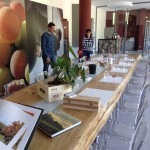On a wet miserable day recently I started this update on the diet incorporating that week and other recent highlights. Friday started well with warm sunshine and work in the garden and a light lunch of jamon Iberico and asparagus sauted with chorizo, and the daily walk with the dogs and finished better with aperitivi (Scarzello 2011 Nebbiolo) at al nido della cinciallegra in Neive and a tagliatta at La Torre del Monastero also abetted by Nebbiolo. Thursday was a “fast day” with golf (helped by forgetting the carrots and celery) and salad for tea with just water. Wednesday ended with dinner at Stefano Paganini‘s and a superb Barbaresco Riserva Montestefano 2009 from Produttori del Barbaresco. Tuesday included a lovely 2 course “worker’s lunch” at i due regni for just €10! Monday was water and asparagus; enough said. Sunday lunchtime, drinks at the circolo in Castagnole followed by Asian chicken noodle salad and Ca del Baio Langhe Nebbiolo at home. Saturday’s highlight was my favourite (until black truffles arrive) Napoli pizza with onion and a seafood special one for HO at Pizzeria Il Camino. I love dieting.
This simple diet is helping shed the surplus kgs added during a recent trip to Tokyo where we overindulged our passion for Japanese food. 6 days of sushi, sashimi, shabu shabu, udon, ramen, tempura, tepanyaki, yakitori, donzeu, curry and beer and just a couple of bottles of wine. BA 1st class on air miles didn’t help.
We’ve also managed some new winery visits and added them to our favourites. These included the quirky Ettore Germano who is constantly changing his philosophy and indulging his passion for white wine and bubbles. His current preference is for thin, untoasted french oak barrels (Ardour) of 700l which although more oxygen. He has also introduced screw-top bottles recently because he feels the quality of corks is declining due to impatience with the harvesting (12 years minimum).
Since 1856 to around 20 years ago the family mainly sold the grapes rather than produce wine. As is a recurring theme in the region, it is the younger generation (son Sergio) who return from studying at oenological college and provide the impetus to produce wine and market it under the house name. Since 1856 the estate has grown from 6h to 10h in Serralunga for red wines plus 5h in Cigliè in Alta Lagna solely for the cultivation of varieties used for white wines.
What turned us on?
Rosana Brut Rosé Metodo Classico- I’m beginning to develop a taste for sparking Nebbiolo with its characteristic tannic length. Throw in a strawberry nose and summer is taken care of.
Langhe Nascetta- not a grape I am familiar with but this unusual wine was almost salty? It had me looking round to see if there were any fresh anchovies which it would have complemented perfectly.
Langhe Chardonnay that had only been in the bottle 3 weeks was all pear drops and fruit salad (the sweets).
Barbera d’Alba Superiore “Vigne della Madre” had a fudgey nose, fresh fruity acidity and top length
As you would expect from Serralunga the Barolos were top drawer, particularly the muscular 2009 Cerretta with its intense length and black pepper finish and the elegantly complex 2007 Lazzarito Riserva.
I wanted to like the Riesling but the bottle we tried had been open a while so I brought some home to try fresh. It has strong competition in my house from Germany (Naher) and Ca del Baio. The Alta Langa Brut (80% Pinot Nero, 20% Chardonnay released after 30 months (24months on the lees) lacked a bit of fruit but was OK. The Langhe Nebbiolo, to me, had a stewed rhubarb nose and was a bit flat on the finish.
Demarie in Vezza d’Alba really seems to be going places and the recently opened new cantina and huge modern tasting room are tremendous. Attention to detail includes white pebbles on the floor that absorb and release humidity. The tasting room can seat 50 and the table is spectacular made from a single tree.
It’s a relatively large family operation for the zone producing just over 100k bottles from their 18-20 hectares. They sell worldwide but particularly in the USA which accounts for almost 30% with one importer in Atlanta accounting for 18-20% (Uva Imports) but their share is sensibly capped.Other major markets are Germany, Switzerland, Japan, Poland and South Korea. 5% is sold “sfuso” locally. Around 35% of production is aged in stainless steel, 40% in botti grandi and the balance in barrique (30% new and the balance 2-3 years old.
My favourite wine was the classic Roero Arneis 2013- floral, minerality, good acidity and length.
The Barbera Superiore 2011 had an extremely fruity nose of strawberry and dark cherry. Wood very understated but relatively low acidity.
The Roero Riserva (nebbiolo) 2009 was still young and tannic but soft and subtle . Fresh ground pepper and leathery. It faces stiff competition from Deltetto at a similar price just down the road, but demonstrated how good nebbiolo can be from the other side of the Tanaro or as I say “in the cheap seats”
The Barolo 2010 was definitely from the “dark side” exhibiting leather and tobacco and despite having been open for a couple of days still fresh.






